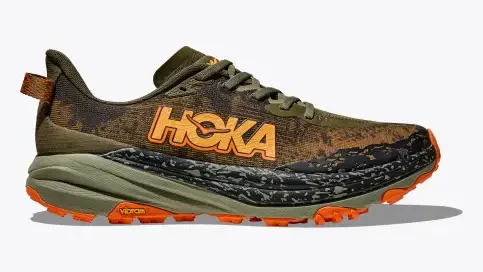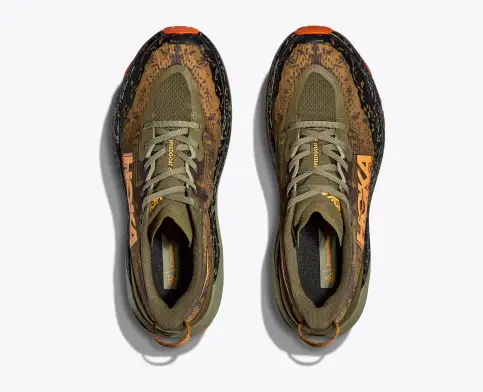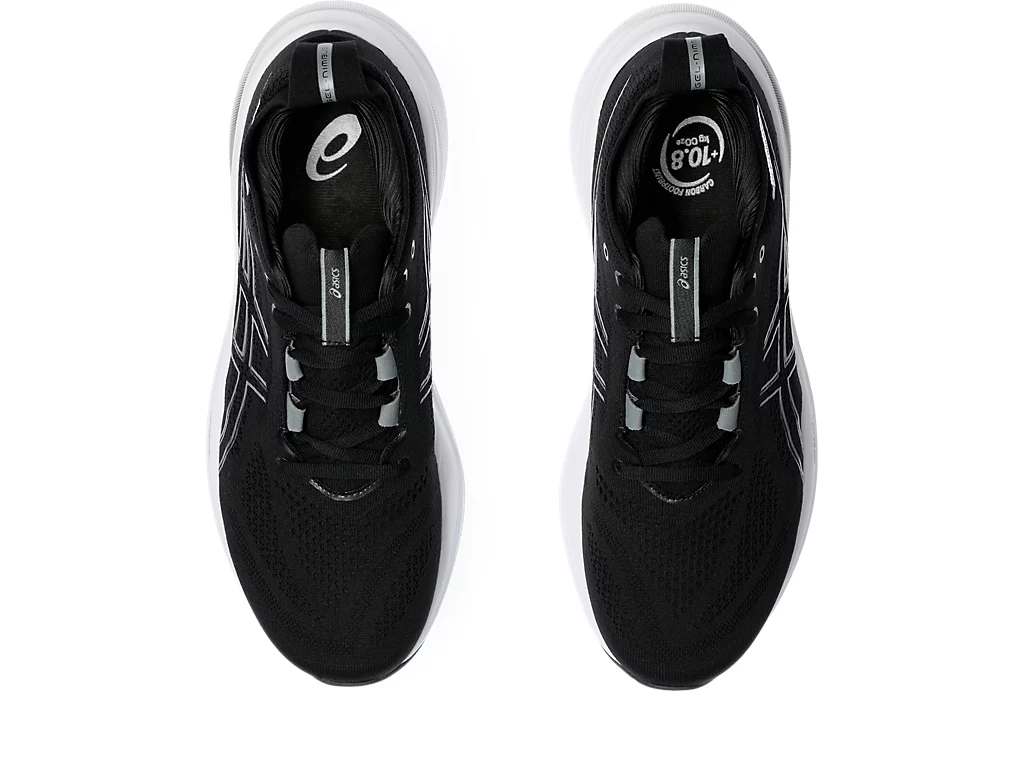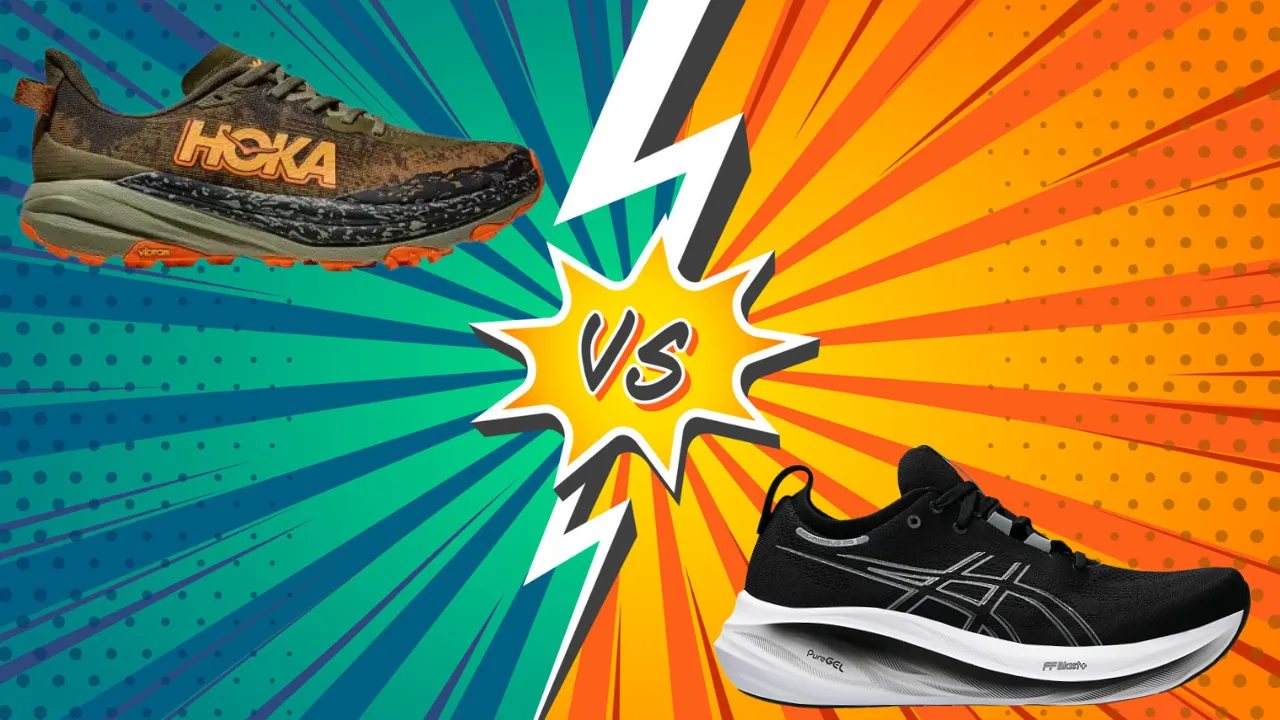Are you torn between hitting the trails or pounding the pavement? In this head-to-head comparison, we’re putting two popular running shoes under the microscope: the rugged Hoka Speedgoat 6 and the cushioned Asics Nimbus 26.
While they serve different purposes, both have garnered significant attention in the running community. Let’s break down their features, performance, and value to help you make an informed decision.
Key Takeaways:
- The Hoka Speedgoat 6 excels in trail running with its aggressive 5mm lugs and durable construction, while the Asics Nimbus 26 dominates road running with superior cushioning. Choose based on your primary running environment.
- For all-day comfort and extended walking on pavement, the Nimbus 26 is the better choice with its plush cushioning and soft knit upper. The Speedgoat’s trail-focused design makes it less ideal for urban use.
- Both shoes offer neutral support, but in different ways: The Speedgoat 6 provides stability through its internal chassis for technical terrain, while the Nimbus 26 caters to neutral and underpronation needs on flat surfaces.
- Despite a similar price point ($155 vs $160), the shoes offer value differently – Speedgoat 6 through durability and technical performance, Nimbus 26 through premium cushioning and eco-friendly materials.
- For plantar fasciitis sufferers, the Nimbus 26 edges ahead with its maximum cushioning and superior impact absorption, though both shoes offer supportive features for this condition.
Quick Comparison Table:
| Feature | Hoka Speedgoat 6 | Asics Nimbus 26 |
|---|---|---|
| Stability | Neutral with internal support chassis | Neutral with underpronation support |
| Flexibility | Moderate | High |
| Sizing | True to size with wider toebox | True to size with engineered knit stretch |
| Weight | 9.80 oz | 10.8 oz |
| Cushion | Balanced responsive cushioning | Maximum cushioning |
| Outsole | Vibram® Megagrip with 5mm lugs | AHAR®PLUS™ and ASICS®GRIP™ rubber |
| Midsole | Lightweight responsive foam | FF BLAST™ PLUS ECO technology |
| Upper | Lightweight woven textile | Engineered knit with recycled content |
| Retail Price | $155 | $160 |
Features Comparison:
Material:
The Speedgoat 6 showcases a durable construction with its Vibram® Megagrip outsole, featuring aggressive 5mm lugs for superior trail grip. The lightweight woven textile upper provides breathability while maintaining durability.


In contrast, the Nimbus 26 utilizes eco-friendly materials, with AHAR®PLUS™ outsole rubber and an engineered knit upper made from 75% recycled content. The PureGEL® technology in the midsole offers distinctive cushioning properties, making it more suitable for road running.
Durability:
Trail-focused Speedgoat 6 is built to withstand rough terrain with its reinforced toe bumper and robust Vibram® outsole. The internal support chassis adds structural integrity without excess weight.
The Nimbus 26 demonstrates excellent road-running durability through its AHAR®PLUS™ outsole technology, though it may show wear faster on trails. Both shoes maintain their cushioning properties well over time, but the Speedgoat has an edge in overall durability due to its trail-specific construction.
Fit:
The Speedgoat 6 features a dynamic vamp that accommodates forefoot spread during long trail runs, while the dual-sided gusseted tongue prevents debris infiltration. Its internal support chassis ensures a secure midfoot lock.


The Nimbus 26 offers a different approach with its engineered knit upper that adapts to foot shape, providing a sock-like fit. The knit tongue and collar create a plush, comfortable feel around the ankle, though it may feel looser than the Speedgoat’s precise fit.
Cushioning:
Speedgoat 6 balances protection and responsiveness with its lightweight foam compound, designed for varied terrain impact absorption. The 5mm drop promotes natural foot movement while maintaining adequate cushioning for technical trails.
The Nimbus 26 excels in this category with its FF BLAST™ PLUS ECO cushioning and PureGEL® technology, providing maximum impact absorption. Its 8mm drop and softer cushioning create a cloud-like feeling ideal for road running.
Stability:
The Speedgoat 6 achieves stability through its symmetrical cushion bed and internal support chassis, providing neutral support without overcorrection. The 5mm lugs add ground contact stability on uneven surfaces.
The Nimbus 26 caters to neutral and underpronation needs with its structured midsole design. While both shoes offer neutral support, the Speedgoat provides better technical terrain stability, while the Nimbus excels on flat surfaces.
Value for Money:
At $155, the Speedgoat 6 offers excellent value for trail enthusiasts, delivering durability and technical performance. The Nimbus 26, priced at $160, justifies its cost through premium cushioning and eco-friendly materials.
Both shoes represent good investments in their respective categories, though the Speedgoat may offer better long-term value due to its durability, while the Nimbus provides superior comfort for road runners.
Performance Testing:
Walking:
The Nimbus 26 edges ahead for casual walking with its plush FF BLAST™ PLUS ECO cushioning and comfortable knit upper. The generous cushioning and 8mm drop create a smooth heel-to-toe transition ideal for extended walks on pavement.
While the Speedgoat 6 performs admirably on trails and rough terrain walks, its aggressive lugs and firmer cushioning make it less optimal for casual urban walking. The Nimbus’s softer cushioning and road-focused design better serve everyday walking needs.
Running:
For trail running, the Speedgoat 6 dominates with its precise fit, responsive cushioning, and superior traction. The internal support chassis and 5mm lugs provide confidence on technical terrain.
The Nimbus 26 shines on roads, offering exceptional impact absorption and smooth transitions through its FF BLAST™ PLUS ECO technology. Each excels in its intended environment – Speedgoat for trails, Nimbus for roads – making direct comparison difficult without considering intended use.
Standing:
The Nimbus 26 takes the lead for all-day comfort with its maximum cushioning and soft engineered knit upper. The PureGEL® technology provides consistent comfort during extended standing periods.
While the Speedgoat 6 offers adequate support, its trail-focused design and firmer cushioning make it less ideal for prolonged standing on hard surfaces. The Nimbus’s plusher cushioning and broader platform better serve those needing all-day comfort on flat surfaces.
Plantar Fasciitis:
Both shoes offer helpful features for plantar fasciitis sufferers. The Nimbus 26’s maximum cushioning and FF BLAST™ PLUS ECO technology provide excellent impact absorption and heel support.
The Speedgoat 6’s balanced cushioning and supportive chassis also help, though some may find its firmer ride less comfortable. For road runners with plantar fasciitis, the Nimbus’s softer cushioning might provide better symptom relief.
Conclusion: Which Is Better For You?
Choose the Hoka Speedgoat 6 if you’re primarily a trail runner seeking a durable, responsive shoe with excellent traction and stability on technical terrain.
Opt for the Asics Nimbus 26 if you’re a road runner looking for maximum cushioning, comfort, and eco-friendly materials. Your running environment and comfort preferences should guide your decision – both shoes excel in their intended uses but serve distinctly different purposes.

